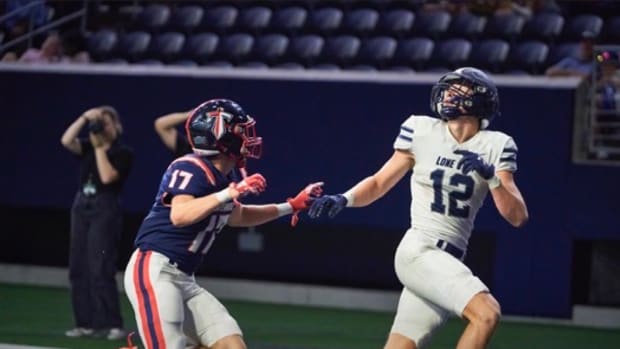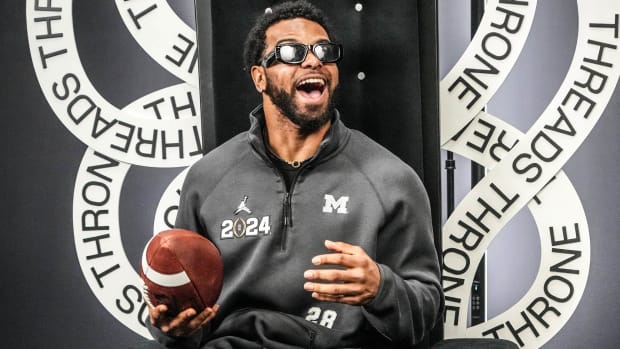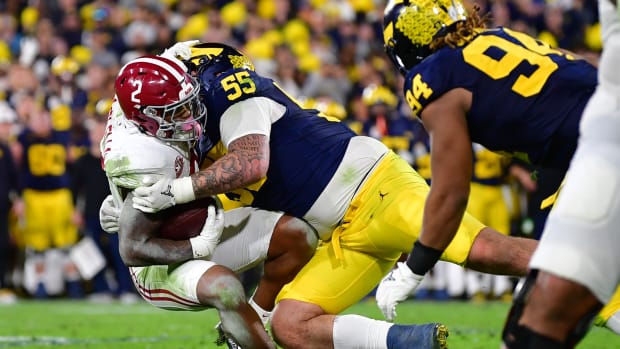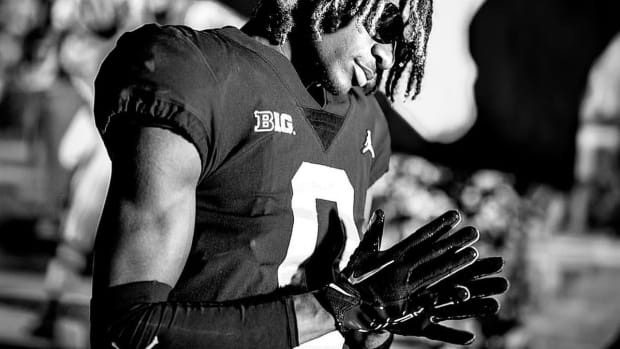Questions We're Asking Following Michigan's 44-10 Win
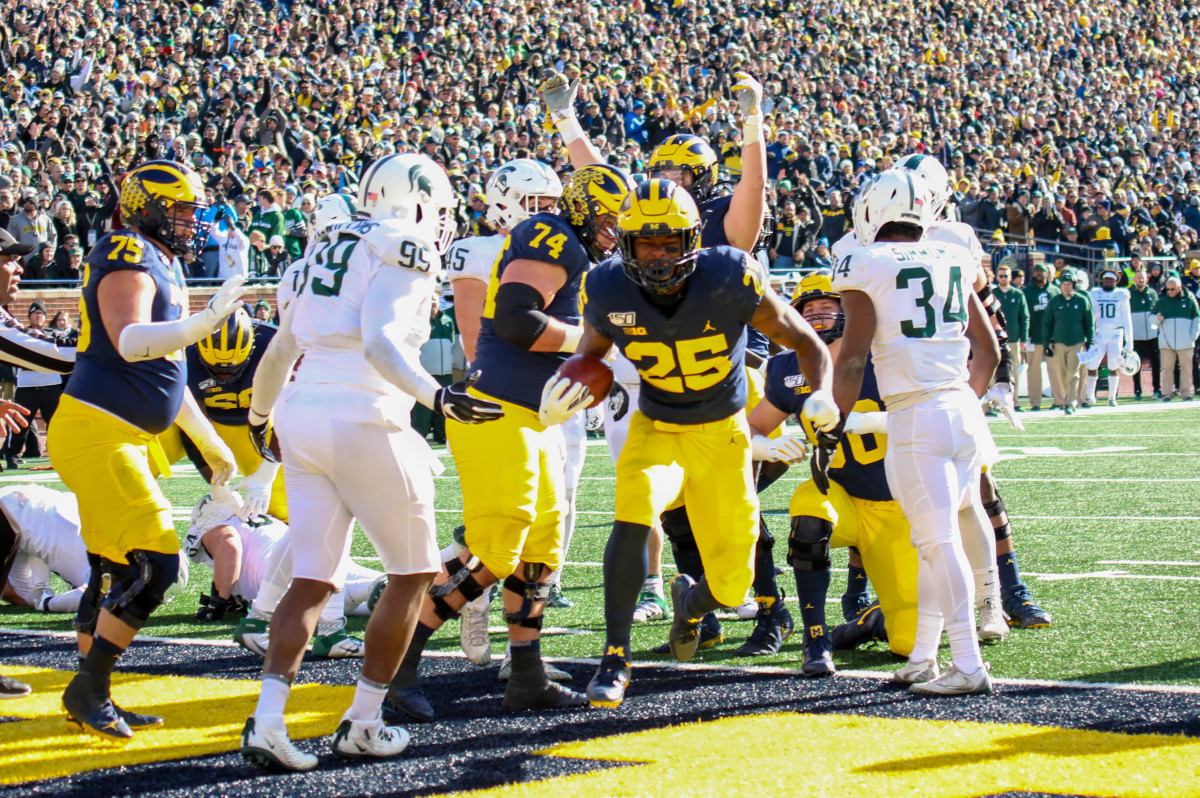
Can Michigan replicate this performance against Ohio State?
Let's be specific - replicate it offensively. No one should expect the Wolverines to hold the nation's highest-scoring offense (51.5 points per game for Ohio State) and fourth-best total offense (541.7 yards per game) to 10 points and 220 yards, like it did Saturday to a floundering Michigan State team.
Wisconsin, in a 38-7 loss, held OSU to 430 yards of offense. That might be considered a win in two weeks for the Maize and Blue. In fact, give up 38 points to Ohio State and the Wolverines probably give themselves a chance.
What Michigan did yesterday was demonstrate two important things: 1) it understood a game plan built around the run when facing one of the nation's best rush defenses (No. 14, 105.6 yards allowed per game) is not the best strategy. 2) U-M acknowledged in today's college football, passing attacks that put their best athletes in positions to make big plays is key.
U-M had spent the better part of October and its first game of November developing a powerhouse rushing attack to the point it looked like the plan going into the final three games would be similar to 2018: run, run, run to possess the football, win field position, play great defense and hope to come out of the Ohio State game with a 24-21 type victory.
That approach made me and others shudder, as it was the the same plan in Columbus a year ago and Ryan Day proved on that November Saturday, old-school 1980s football won't work against the Scarlet and Gray.
But, you had no choice but to come on board with that plan of attack because between Zach Charbonnet, Hassan Haskins and Tru Wilson, U-M had three hardened, move-the-chains, nose-for-the-end zone backs, but largely because the passing game was so inconsistent (Shea Patterson entered yesterday's game completing 57.2 percent of his attempts for the season) without taking advantage of its big-play threats (Michigan entered the MSU game averaging 3.6 pass completions of 20 yards or more).
Then the game plan and execution against State turned every notion of what this offense is and what it can be on its head. Patterson completed 72.7 percent of his passes, had six completions of 20 yards or more (and an additional five of 16+ yards), finished with 384 yards and made great use of receivers Ronnie Bell, Nico Collins, Donovan Peoples-Jones, Mike Sainristil and Cornelius Johnson, and tight ends Sean McKeon and Nick Eubanks.
So, can the Wolverines replicate their passing success against a Buckeye team that leads the nation in yards allowed per game (126.0), is second in passer rating (90.43), first in yards per attempt (4.9) and sixth in completion percentage (51.4)?
U-M has no choice because running the football won't prove fruitful either: OSU sits sixth nationally in surrendering just 90.4 yards per game and is fourth in allowing only 2.51 yards per attempt.
The truth of the matter is Michigan has a better chance of being successful throwing the ball (if it can keep pass rusher Chase Young and Co. at bay) because it is more difficult to defend receivers in space than it is to crowd the box with seven defenders and close down running lanes.
Think about Michigan's big plays in the passing game Saturday - Bell and Peoples-Jones on bubble screens out in space with Collins and Black (or Bell or DPJ) blocking man-coverage cornerbacks; Bell finding soft pockets over the middle against zone defense; Collins and McKeon on post patterns in which teammates occupy the attention of the high safety.
These aren't difficult plays for Michigan State to defend, they're difficult plays for any defense to cover. Even one as talented and accomplished as Ohio State is this season.
Want proof? Michigan was one of the top defenses in college football in 2018 but the Maize and Blue couldn't defend receivers in space at OSU, few teams can.
Defenses will have their successes (thanks in good part because of pressure on the QB) but the entire spread-offense movement changed college football forever because it put skilled athletes in desirable one-on-one situations, and what we saw from the Wolverines Saturday was the coaching staff taking advantage of the near-impossibility it is for a defense to defend large swaths of space.
It was brilliant. And it can work against Ohio State too.
Are you having any fun? (You should be)
If you're like me, the loss in Madison was soul-crushing not only because of the way the game unfolded - Wisconsin dominating in racing out to a 35-0 lead - but in what it meant for the rest of the season. The likelihood of U-M going 8-4 looked far more likely than Michigan going 11-1 or even 10-2.
In an instant, three games into the season, it looked like the year would be one of disappointment and frustration, and that's no way to enjoy football.
What the Wolverines have done since then (with the exception of one half of football at Penn State) is make the season fun again.
Blowout wins of Rutgers and Maryland don't really register but a Homecoming victory over Iowa, a tough road win at Illinois and two lopsided beatdowns of rivals Notre Dame and Michigan State sure have given U-M and its fans reason to pound their chest and grin ear to ear.
How satisfying have the latter two been? In the last 50 years, Michigan has never beaten ND and MSU by a combined score as badly as it has this season. The Wolverines' total margin of 65 points (45-14 and 44-10) is 20 points better than the program's previous high of 45 points in 2003 (38-0 over the Irish and 27-20 over State) and the 44 points in 2006 (47-21 over ND and 31-13 over MSU).
Michigan had never beaten Notre Dame and Michigan State by 30+ apiece in the same season but has done so this year.
Assuredly how THE Game goes down will ultimately write the script for 2019, but for now, flex a little, stick your chest out and have a little fun.

